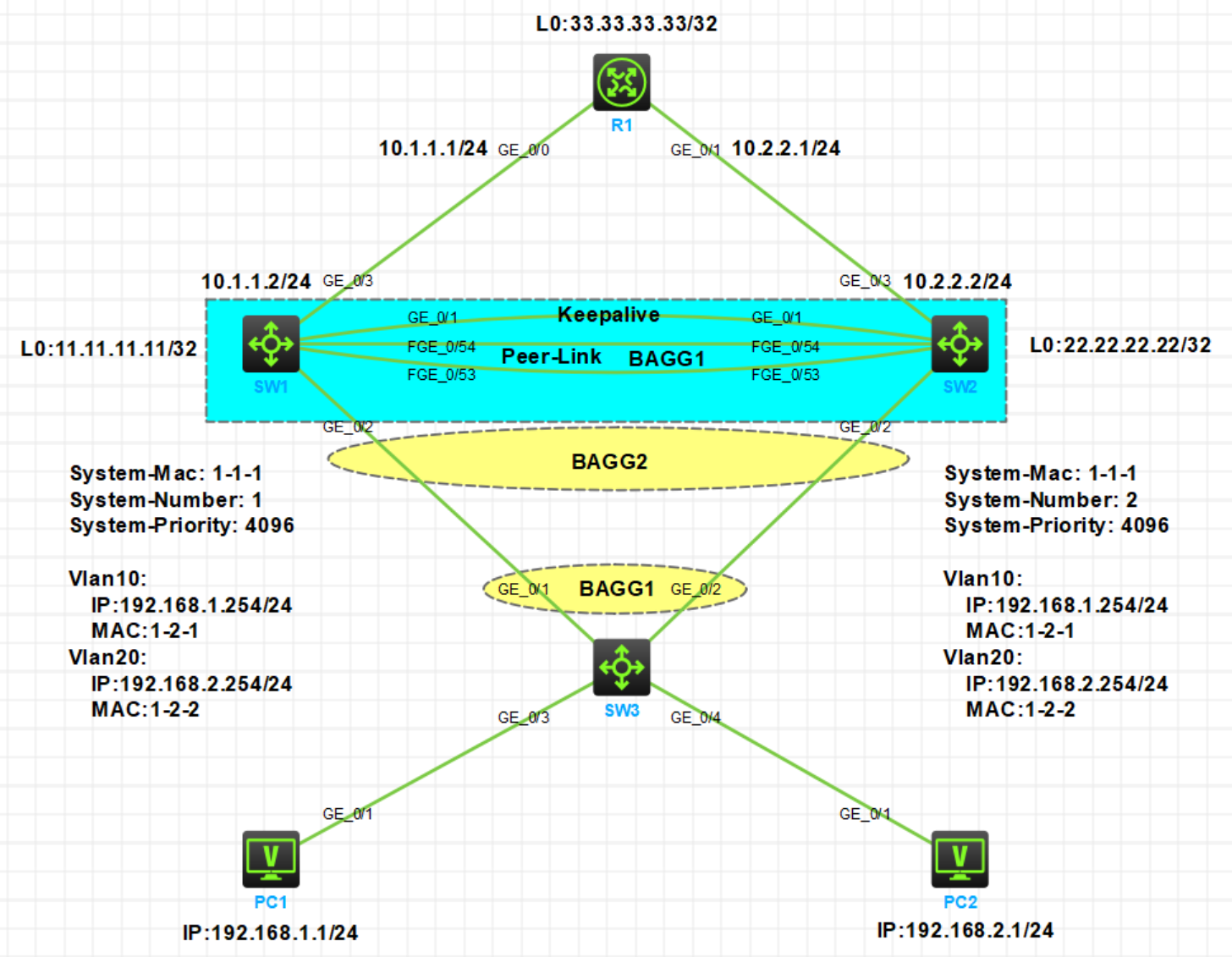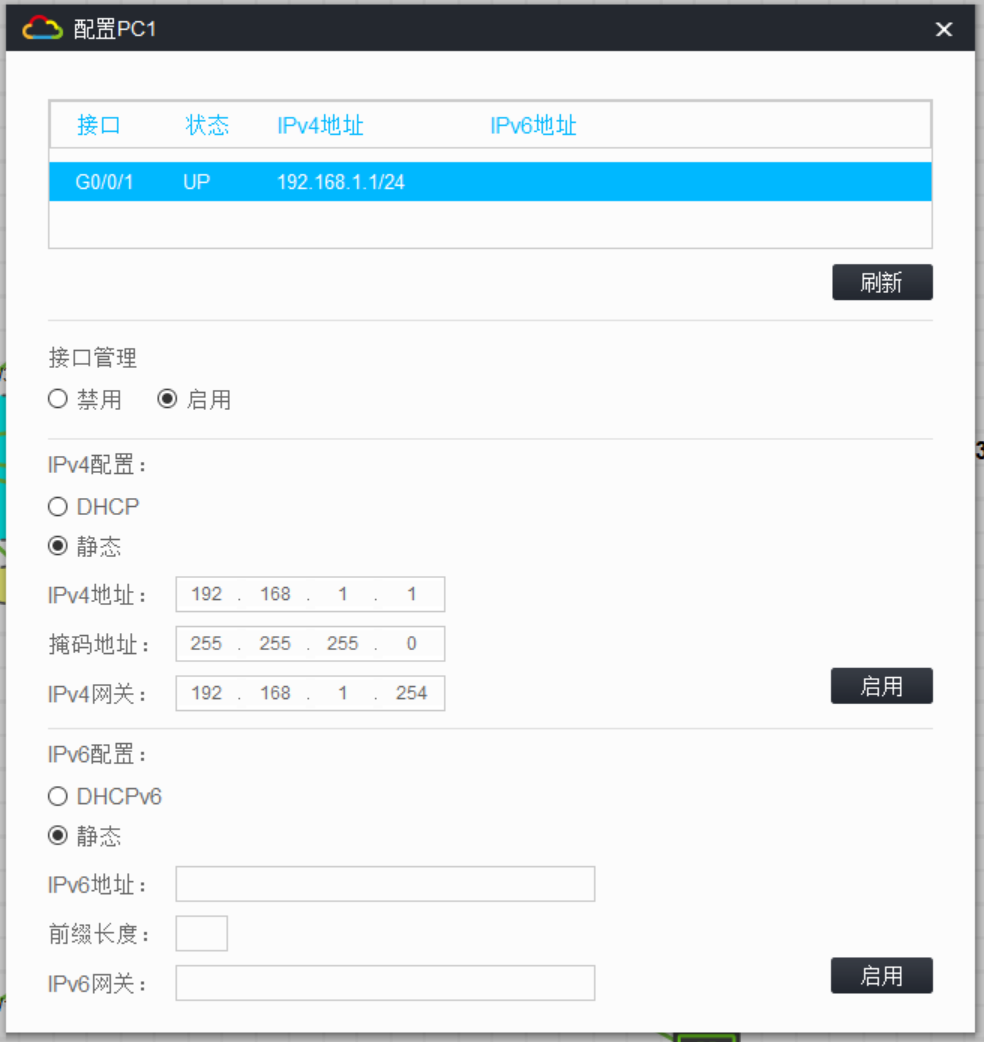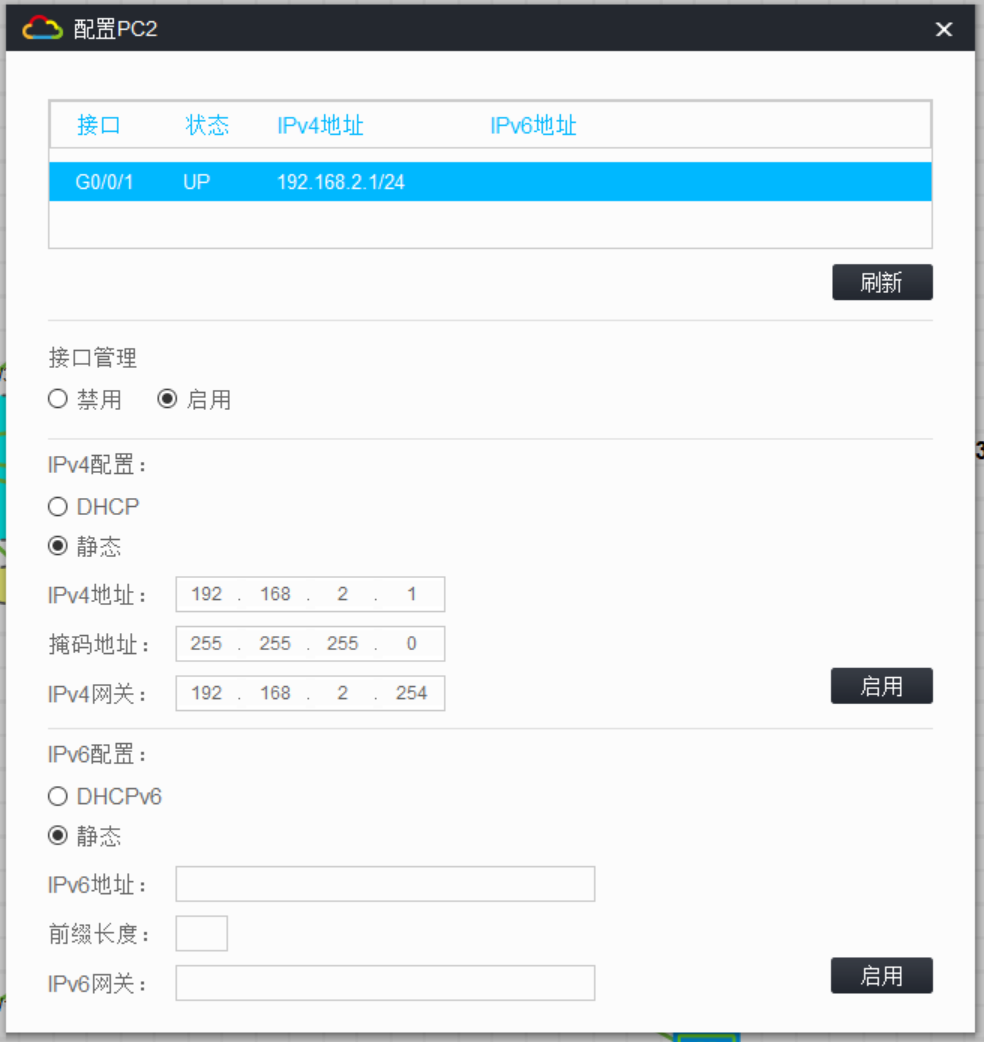H3C M-LAG与双活网关接口结合应用场景实验
实验拓扑

实验需求
- 此实验需要在模拟器中使用交换机型号 S6850
- SW3 为接入交换机,连接 PC1 在 VLAN 10,连接 PC2在 VLAN 20,SW3 双上行连接到两台核心交换机
- SW1 和 SW2 为核心交换机,配置 M-LAG,并作为 VLAN 10 和 VLAN 20 的三层网关,下行跨设备聚合对接接入交换机 SW3。上行不配置 M-LAG,分别通过两条链路接入到路由器 R1
实验步骤
PC1和PC2分别如图示配置IP地址


在SW3上创建VLAN10和VLAN20,连接PC1和PC2的接口分别以Access类型接入到VLAN10和VLAN20
[SW3] vlan 10
[SW3] vlan 20
[SW3] interface GigabitEthernet1/0/3
[SW3-GigabitEthernet1/0/3] port access vlan 10
[SW3] interface GigabitEthernet1/0/4
[SW3-GigabitEthernet1/0/4] port access vlan 20
配置 SW1 和 SW2 形成 M-LAG 系统
修改 SW1 系统 MAC 地址为 1-1-1,系统编号为 1,优先级 4096
[SW1]m-lag system-mac 1-1-1
Changing the system MAC address might flap the peer link and cause M-LAG system setup failure. Continue? [Y/N]:y
[SW1]m-lag system-number 1
Changing the system number might flap the peer link and cause M-LAG system setup failure. Continue? [Y/N]:y
[SW1]m-lag system-priority 4096
Changing the system priority might flap the peer link and cause M-LAG system setup failure. Continue? [Y/N]:y
在 SW1 上配置 G1/0/1 口为 Keepalive 接口,Keepalive 源地址为本端 1.1.1.1,目的地址为 SW2 的 1.1.1.2,并在 MAD 中排除 Keepalive 接口
[SW1]m-lag keepalive ip destination 1.1.1.2 source 1.1.1.1
[SW1]interface GigabitEthernet1/0/1
[SW1-GigabitEthernet1/0/1]port link-mode route
[SW1-GigabitEthernet1/0/1]ip address 1.1.1.1 24 //Keepalive 接口 IP 地址可自定义网络中未使用的地址,双方 Keepalive 口地址需要在同一网段
[SW1]m-lag mad exclude interface GigabitEthernet1/0/1
在 SW1 上把 FGE1/0/53 和 FGE1/0/54 口加入到 BAGG1 动态聚合口,并把该聚合口配置为 SW1 的 Peer-link 口
[SW1]interface Bridge-Aggregation 1
[SW1-Bridge-Aggregation1]link-aggregation mode dynamic
[SW1]interface range fge1/0/53 fge1/0/54
[SW1-if-range]port link-aggregation group 1
[SW1]interface Bridge-Aggregation 1
[SW1-Bridge-Aggregation1]port m-lag peer-link 1
由于模拟器不支持关闭报文入接口与静态MAC地址表项匹配检查功能,特此说明实际环境中Peer-link口需要配置undo mac-address static source-check enable
修改 SW2 系统 MAC 地址与 SW1 相同为 1-1-1,系统编号为 2,优先级 4096
[SW2]m-lag system-mac 1-1-1
Changing the system MAC address might flap the peer link and cause M-LAG system setup failure. Continue? [Y/N]:y
[SW2]m-lag system-number 2
Changing the system number might flap the peer link and cause M-LAG system setup failure. Continue? [Y/N]:y
[SW2]m-lag system-priority 4096
Changing the system priority might flap the peer link and cause M-LAG system setup failure. Continue? [Y/N]:y
在 SW2 上配置 G1/0/1 口为 Keepalive 接口,Keepalive 源地址为本端 1.1.1.2,目的地址为 SW1 的 1.1.1.1,并在 MAD 中排除 Keepalive 接口
[SW2]m-lag keepalive ip destination 1.1.1.1 source 1.1.1.2
[SW2]interface GigabitEthernet1/0/1
[SW2-GigabitEthernet1/0/1]port link-mode route
[SW2-GigabitEthernet1/0/1]ip address 1.1.1.2 24
[SW2]m-lag mad exclude interface g1/0/1
在 SW2 上把 FGE1/0/53 和 FGE1/0/54 口加入到 BAGG1 动态聚合口,并把该聚合口配置为 SW2 的 Peer-link 口
[SW2]interface Bridge-Aggregation 1
[SW2-Bridge-Aggregation1]link-aggregation mode dynamic
[SW2]interface range fge1/0/53 fge1/0/54
[SW2-if-range]port link-aggregation group 1
[SW2]interface Bridge-Aggregation 1
[SW2-Bridge-Aggregation1]port m-lag peer-link 1
由于模拟器不支持关闭报文入接口与静态MAC地址表项匹配检查功能,特此说明实际环境中Peer-link口需要配置undo mac-address static source-check enable
此时在 SW1 和 SW2 上可以查看到 M-LAG 系统已经建立
[SW1]display m-lag summary
Flags: A -- Aggregate interface down, B -- No peer M-LAG interface configured
C -- Configuration consistency check failed
Peer-link interface: BAGG1
Peer-link interface state (cause): UP
Keepalive link state (cause): UP
[SW2]display m-lag summary
Flags: A -- Aggregate interface down, B -- No peer M-LAG interface configured
C -- Configuration consistency check failed
Peer-link interface: BAGG1
Peer-link interface state (cause): UP
Keepalive link state (cause): UP
在 SW1 和 SW2 上配置下连 SW3 的接口为 M-LAG 接口,实现跨设备聚合
在 SW1 上创建 BAGG2 动态聚合口,把连接 SW3 的接口加入该聚合口,并设置为 M-LAG 接口
[SW1]interface Bridge-Aggregation 2
[SW1-Bridge-Aggregation2]link-aggregation mode dynamic
[SW1]interface GigabitEthernet1/0/2
[SW1-if-range]port link-aggregation group 2
[SW1]interface Bridge-Aggregation 2
[SW1-Bridge-Aggregation2]port m-lag group 1
在 SW2 上创建 BAGG2 动态聚合口,把连接 SW3 的接口加入该聚合口,并设置为 M-LAG 接口
[SW2]interface Bridge-Aggregation 2
[SW2-Bridge-Aggregation2]link-aggregation mode dynamic
[SW2]interface GigabitEthernet1/0/2
[SW2-if-range]port link-aggregation group 2
[SW2]interface Bridge-Aggregation 2
[SW2-Bridge-Aggregation2]port m-lag group 1
在 SW3 上创建 BAGG1 动态聚合口,把连接 SW1 和 SW2 的接口加入该聚合口
[SW3]interface Bridge-Aggregation 1
[SW3-Bridge-Aggregation1]link-aggregation mode dynamic
[SW3]interface range g1/0/1 to g1/0/2
[SW3-if-range]port link-aggregation group 1
此时在 SW1,SW2 和 SW3 上可以查看到跨设备链路聚合已经正常工作
[SW1]display link-aggregation summary
Aggregation Interface Type:
BAGG -- Bridge-Aggregation, BLAGG -- Blade-Aggregation, RAGG -- Route-Aggregation, SCH-B -- Schannel-Bundle
Aggregation Mode: S -- Static, D -- Dynamic
Loadsharing Type: Shar -- Loadsharing, NonS -- Non-Loadsharing
Actor System ID: 0x8000, 2898-b168-0200
AGG AGG Partner ID Selected Unselected Individual Share
Interface Mode Ports Ports Ports Type
--------------------------------------------------------------------------------
BAGG1 D 0x8000, 2898-b66c-0300 2 0 0 Shar
BAGG2 D 0x8000, 2898-b9f6-0400 1 0 0 Shar
[SW2]display link-aggregation summary
Aggregation Interface Type:
BAGG -- Bridge-Aggregation, BLAGG -- Blade-Aggregation, RAGG -- Route-Aggregation, SCH-B -- Schannel-Bundle
Aggregation Mode: S -- Static, D -- Dynamic
Loadsharing Type: Shar -- Loadsharing, NonS -- Non-Loadsharing
Actor System ID: 0x8000, 2898-b66c-0300
AGG AGG Partner ID Selected Unselected Individual Share
Interface Mode Ports Ports Ports Type
--------------------------------------------------------------------------------
BAGG1 D 0x8000, 2898-b168-0200 2 0 0 Shar
BAGG2 D 0x8000, 2898-b9f6-0400 1 0 0 Shar
[SW3]display link-aggregation summary
Aggregation Interface Type:
BAGG -- Bridge-Aggregation, BLAGG -- Blade-Aggregation, RAGG -- Route-Aggregation, SCH-B -- Schannel-Bundle
Aggregation Mode: S -- Static, D -- Dynamic
Loadsharing Type: Shar -- Loadsharing, NonS -- Non-Loadsharing
Actor System ID: 0x8000, 2898-b9f6-0400
AGG AGG Partner ID Selected Unselected Individual Share
Interface Mode Ports Ports Ports Type
--------------------------------------------------------------------------------
BAGG1 D 0x1000, 0001-0001-0001 2 0 0 Shar
在 SW1 和 SW2 上为 VLAN 10 和 VLAN 20 创建三层接口,两端配置相同的 MAC 地址和 IP 地址
在 SW1 和 SW2 上创建 VLAN 10 和 VLAN 20,把 SW1、SW2 和 SW3 之间相连的聚合口配置为 Trunk,并允许 VLAN 10 和 VLAN 20 通过
[SW1] vlan 10
[SW1] vlan 20
[SW1]interface Bridge-Aggregation2
[SW1-Bridge-Aggregation2]port link-type trunk
[SW1-Bridge-Aggregation2]port trunk permit vlan all
[SW2] vlan 10
[SW2] vlan 20
[SW2]interface Bridge-Aggregation2
[SW2-Bridge-Aggregation2]port link-type trunk
[SW2-Bridge-Aggregation2]port trunk permit vlan all
[SW3]interface Bridge-Aggregation1
[SW3-Bridge-Aggregation1]port link-type trunk
[SW3-Bridge-Aggregation1]port trunk permit vlan all
在 SW1 上创建 VLAN 10 和 VLAN 20 的三层接口,配置 MAC 地址和 IP 地址
[SW1]interface Vlan-interface 10
[SW1-Vlan-interface10]mac-address 1-2-1
[SW1-Vlan-interface10]ip address 192.168.1.254 24
[SW1]interface Vlan-interface 20
[SW1-Vlan-interface20]mac-address 1-2-2
[SW1-Vlan-interface20]ip address 192.168.2.254 24
在 SW2 上创建 VLAN 10 和 VLAN 20 的三层接口,配置与 SW1 相同的 MAC 地址和 IP 地址
[SW2]interface Vlan-interface 10
[SW2-Vlan-interface10]mac-address 1-2-1
[SW2-Vlan-interface10]ip address 192.168.1.254 24
[SW2]interface Vlan-interface 20
[SW2-Vlan-interface20]mac-address 1-2-2
[SW2-Vlan-interface20]ip address 192.168.2.254 24
在 SW1 和 SW2 上配置上行接口 IP 地址,配置 R1 的 IP 地址
[SW1]interface GigabitEthernet 1/0/3
[SW1-GigabitEthernet1/0/3]port link-mode route
[SW1-GigabitEthernet1/0/3]ip address 10.1.1.2 24
[SW1]interface LoopBack 0
[SW1-LoopBack0]ip address 11.11.11.11 32
[SW2]interface GigabitEthernet 1/0/3
[SW2-GigabitEthernet1/0/3]port link-mode route
[SW2-GigabitEthernet1/0/3]ip address 10.2.2.2 24
[SW2]interface LoopBack 0
[SW2-LoopBack0]ip address 22.22.22.22 32
[R1]interface GigabitEthernet 0/0
[R1-GigabitEthernet0/0]ip address 10.1.1.1 24
[R1]interface GigabitEthernet 0/1
[R1-GigabitEthernet0/1]ip address 10.2.2.1 24
[R1]interface LoopBack 0
[R1-LoopBack0]ip address 33.33.33.33 32
在 SW1、SW2 和 R1 上配置 OSPF,使路由互通
[SW1]ospf 1 router-id 11.11.11.11
[SW1-ospf-1]area 0.0.0.0
[SW1-ospf-1-area-0.0.0.0]network 1.1.1.0 0.0.0.255
[SW1-ospf-1-area-0.0.0.0]network 10.1.1.0 0.0.0.255
[SW1-ospf-1-area-0.0.0.0]network 192.168.1.0 0.0.0.255
[SW1-ospf-1-area-0.0.0.0]network 192.168.2.0 0.0.0.255
[SW1-ospf-1-area-0.0.0.0]network 11.11.11.11 0.0.0.0
[SW1-ospf-1-area-0.0.0.0]quit
[SW1-ospf-1]silent-interface Vlan-interface10
[SW1-ospf-1]silent-interface Vlan-interface20
[SW2]ospf 1 router-id 22.22.22.22
[SW2-ospf-1]area 0.0.0.0
[SW2-ospf-1-area-0.0.0.0]network 1.1.1.0 0.0.0.255
[SW2-ospf-1-area-0.0.0.0]network 10.1.1.0 0.0.0.255
[SW2-ospf-1-area-0.0.0.0]network 192.168.1.0 0.0.0.255
[SW2-ospf-1-area-0.0.0.0]network 192.168.2.0 0.0.0.255
[SW2-ospf-1-area-0.0.0.0]network 22.22.22.22 0.0.0.0
[SW2-ospf-1-area-0.0.0.0]quit
[SW2-ospf-1]silent-interface Vlan-interface10
[SW2-ospf-1]silent-interface Vlan-interface20
[R1]ospf 1 router-id 33.33.33.33
[R1-ospf-1]area 0.0.0.0
[R1-ospf-1-area-0.0.0.0]network 10.1.1.0 0.0.0.255
[R1-ospf-1-area-0.0.0.0]network 10.2.2.0 0.0.0.255
[R1-ospf-1-area-0.0.0.0]network 33.33.33.33 0.0.0.0
实验验证
在 PC 上测试能 Ping 通网关和 R1
<H3C>ping 192.168.1.254
Ping 192.168.1.254 (192.168.1.254): 56 data bytes, press CTRL_C to break
56 bytes from 192.168.1.254: icmp_seq=0 ttl=255 time=1.103 ms
56 bytes from 192.168.1.254: icmp_seq=1 ttl=255 time=0.406 ms
56 bytes from 192.168.1.254: icmp_seq=2 ttl=255 time=0.652 ms
56 bytes from 192.168.1.254: icmp_seq=3 ttl=255 time=0.898 ms
56 bytes from 192.168.1.254: icmp_seq=4 ttl=255 time=0.853 ms
--- Ping statistics for 192.168.1.254 ---
5 packet(s) transmitted, 5 packet(s) received, 0.0% packet loss
round-trip min/avg/max/std-dev = 0.406/0.782/1.103/0.237 ms
<H3C>%Jun 7 17:32:42:961 2024 H3C PING/6/PING_STATISTICS: Ping statistics for 192.168.1.254: 5 packet(s) transmitted, 5 packet(s) received, 0.0% packet loss, round-trip min/avg/max/std-dev = 0.406/0.782/1.103/0.237 ms.
<H3C>ping 33.33.33.33
Ping 33.33.33.33 (33.33.33.33): 56 data bytes, press CTRL_C to break
56 bytes from 33.33.33.33: icmp_seq=0 ttl=254 time=1.149 ms
56 bytes from 33.33.33.33: icmp_seq=1 ttl=254 time=0.885 ms
56 bytes from 33.33.33.33: icmp_seq=2 ttl=254 time=1.051 ms
56 bytes from 33.33.33.33: icmp_seq=3 ttl=254 time=1.077 ms
56 bytes from 33.33.33.33: icmp_seq=4 ttl=254 time=0.797 ms
--- Ping statistics for 33.33.33.33 ---
5 packet(s) transmitted, 5 packet(s) received, 0.0% packet loss
round-trip min/avg/max/std-dev = 0.797/0.992/1.149/0.130 ms
<H3C>%Jun 7 17:32:49:419 2024 H3C PING/6/PING_STATISTICS: Ping statistics for 33.33.33.33: 5 packet(s) transmitted, 5 packet(s) received, 0.0% packet loss, round-trip min/avg/max/std-dev = 0.797/0.992/1.149/0.130 ms.
<H3C>ping 192.168.2.254
Ping 192.168.2.254 (192.168.2.254): 56 data bytes, press CTRL_C to break
56 bytes from 192.168.2.254: icmp_seq=0 ttl=255 time=0.602 ms
56 bytes from 192.168.2.254: icmp_seq=1 ttl=255 time=0.512 ms
56 bytes from 192.168.2.254: icmp_seq=2 ttl=255 time=0.697 ms
56 bytes from 192.168.2.254: icmp_seq=3 ttl=255 time=0.804 ms
56 bytes from 192.168.2.254: icmp_seq=4 ttl=255 time=1.062 ms
--- Ping statistics for 192.168.2.254 ---
5 packet(s) transmitted, 5 packet(s) received, 0.0% packet loss
round-trip min/avg/max/std-dev = 0.512/0.735/1.062/0.190 ms
<H3C>%Jun 7 17:33:10:860 2024 H3C PING/6/PING_STATISTICS: Ping statistics for 192.168.2.254: 5 packet(s) transmitted, 5 packet(s) received, 0.0% packet loss, round-trip min/avg/max/std-dev = 0.512/0.735/1.062/0.190 ms.
<H3C>ping 33.33.33.33
Ping 33.33.33.33 (33.33.33.33): 56 data bytes, press CTRL_C to break
56 bytes from 33.33.33.33: icmp_seq=0 ttl=254 time=0.787 ms
56 bytes from 33.33.33.33: icmp_seq=1 ttl=254 time=0.859 ms
56 bytes from 33.33.33.33: icmp_seq=2 ttl=254 time=1.196 ms
56 bytes from 33.33.33.33: icmp_seq=3 ttl=254 time=1.060 ms
56 bytes from 33.33.33.33: icmp_seq=4 ttl=254 time=0.943 ms
--- Ping statistics for 33.33.33.33 ---
5 packet(s) transmitted, 5 packet(s) received, 0.0% packet loss
round-trip min/avg/max/std-dev = 0.787/0.969/1.196/0.145 ms
<H3C>%Jun 7 17:33:18:294 2024 H3C PING/6/PING_STATISTICS: Ping statistics for 33.33.33.33: 5 packet(s) transmitted, 5 packet(s) received, 0.0% packet loss, round-trip min/avg/max/std-dev = 0.787/0.969/1.196/0.145 ms.
实验附件
通过百度网盘分享的文件:H3C M-LAG与双活网关接口结合应用场景实验.zip
链接:https://pan.baidu.com/s/1QjtZiMQ5PWo8PgLyn-dZnA?pwd=w70y
实验注意
由于模拟器版本中的6850交换机对应的comware分支存在取消,导致在配置m-lag的时候会有一致性检查不通过的情况
规避方法:
两台成员设备的Peer-link口配置:jumboframe enable 1552
如果两台成员设备的Peer-link口配置:jumboframe enable 1552还是有问题,建议先关闭一致性检测 m-lag consistency-check disable,本实验仅关闭了一致性检测。
且由于模拟器不支持关闭报文入接口与静态MAC地址表项匹配检查功能,特此说明实际环境中Peer-link口需要配置undo mac-address static source-check enable

























 2185
2185

 被折叠的 条评论
为什么被折叠?
被折叠的 条评论
为什么被折叠?










